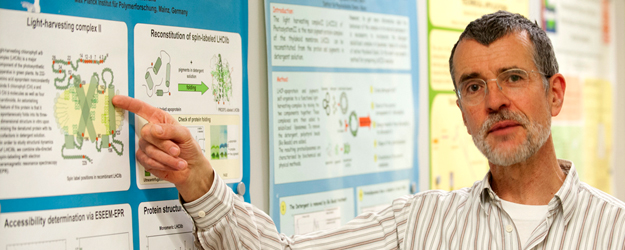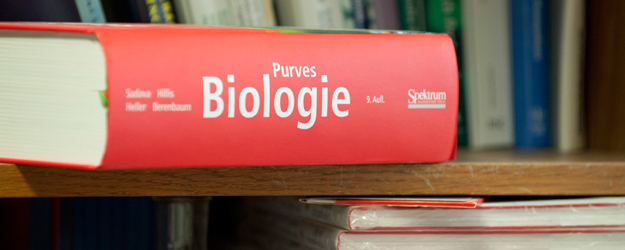23 March 2012
Professor Dr. Harald Paulsen and his team are researching the characteristics of the light-harvesting protein LHCII. The protein and its unusual self-organization skills have fascinated biologists for 20 years. It plays an important role in photosynthesis and may one day majorly increase the efficiency of solar cells.
Professor Dr. Harald Paulsen has no problem at all talking about his research. On the contrary, with his enthusiasm, he is even happy to patiently explain the subject to the general public. "I love telling people how fascinated we are and am really happy when I spark that same interest in others," says the head of the Institute of General Botany at Johannes Gutenberg University Mainz (JGU): The light-harvesting protein LHCII is the focus of his working group, the Paulsen Group. This vital component in the photosynthesis structures of plants tells scientists a lot about the structure of life and may be used to help develop more effective solar cells in the future.
"We do basic research, but we also work application-oriented," explains Paulsen. However, he has to rein in his employees' enthusiasm from time to time when it comes to practical applications. "We are not yet at the point where we can say: 'We will be manufacturing commercial solar cells in ten years.' Some people like to hear these kinds of statements that have public appeal, but I am not so sure they really increase our acceptance."
The basis of life
Paulsen picks up a piece of chalk, his office door can be used as a board. He starts to tell us about his research with a quick sketch about photosynthesis. "This is a plant. It uses sunlight to create sugar from CO2. It is the basis of life."
And it is here that LHCII, which Paulsen and his team are researching, plays an integral role. It is located in plant membranes. "The photosynthesis components in plants are hit by a light packet every ten to hundred seconds when the sun is shining brightly. That by itself would not be enough to keep them alive. So they need a light-harvesting device, a type of solar sail." LHCII becomes just such a solar sail. It generates 100 times greater luminance efficacy. The light-harvesting protein connects fourteen chlorophyll and four carotenoid molecules, a total of eighteen dye molecules.
LHCII folds on its own
"LHCII is unique because we can assemble it in a test tube. Even if we bunch up the protein components into a completely different shape, it will fold back into the right form. We can even manufacture it. We get bacteria to produce LHCII proteins for us by implanting the corresponding genes into them." This produces protein clumps. When the scientists add the right dye molecules it folds into a solar sail. Such a high degree of self-organization is unusual and very interesting for the researchers.
"We are driven by a desire to understand: How does a protein have to be structured so that it can do something like that and how is it able to bind half of its own mass in the form of dye, of pigments? It is fascinating that a complex biological structure can organize itself in such a manner." This is where the research begins to take on an almost playful aspect. We systematically remove areas or add others to see what happens. It is kind of like a child trying to understand how a machine works by shutting down one cog and then another."
Solar cells and plant cells
Paulsen started working with LHCII as a postdoc at Harvard University in the mid-eighties. The passion has never left him. "We understand the light-harvesting protein a lot better than we did ten years ago," he said. But a lot of research still needs to be done, especially when it comes to using the solar sail for power generation.
"Solar cells and plant cells are much more similar than you think," said Paulsen. "Both turn solar energy into a different kind of energy. LHCII harvests light energy and bundles it." It would be the ideal characteristic for electrochemical solar cells. In 1992, Swiss chemist Michael Grätzel patented an electrochemical cell, the Grätzel Cell. It is already in use. Paulsen and his team are now asking the question: How about adding their solar sail to it?
Researching outside of the box
Paulsen pours a tea and talks of the difficulties facing his work. "We cannot see the object of our research; we cannot observe LHCII as it folds." Therefore, new technical equipment needs to be acquired to measure the changes. It can be done, for example, with fluorescence spectroscopy. "Complex research like this always needs teamwork," says Paulsen. "We see working together as a good thing." This is not just true within the Paulsen Group. Experts from various areas in materials sciences and mathematicians, chemists, and physicists are all involved in work on LHCII.
Paulsen does regret that the numerous other duties he has and the offices he holds mean he can no longer spend the time he would like in the lab. "I can no longer do what I originally intended to do: To keep on experimenting actively. To do that I need at least half a day." But that is time he no longer has.
Public should feel the fascination
But even from outside the laboratory he can still feel the draw of the protein: "Even after twenty years LHCII is still incredibly fascinating." Paulsen finds it normal for research to be somewhat complicated. "It should be a bit difficult," he says with a smile. "Otherwise, our students would be disappointed."
Nevertheless, he is convinced everything should be easy to understand because: "The public finances our research, so they should to feel the fascination, too." That is why he finds time to explain what he does despite his busy schedule.



